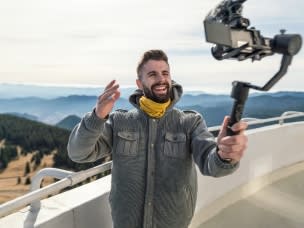Six ways to connect the affiliate channel with in-store
Written by Cameron Rooney on 8 minute read
How can retailers tie their in-store strategy to affiliate marketing to increase footfall, gain new customers and increase customers’ lifetime value?

With under a month to go until England is lifted out of the national lockdown, brands are starting to ramp up preparations to make sure their stores are ready for the grand re-opening on April 12th.
When stores saw their doors close last at the start of 2021, Autumn/Winter stock flooded floorspace, Christmas decorations were still being taken down, and January in-store sales kicked off to a quieter start than previous years, with many customers preferring to shop online than brace indoor environments. When shops re-open next month, we’ll be welcomed to a different sight, with Spring/Summer in full swing and bold, bright campaign imagery dominating windows and in-store marketing.
Across January and February, this year, we’ve seen sales in the UK grow by 75% across the retail sector YoY and an increase of +36% in new customers. With a rise in new customers for retail brands online, it will be important to businesses to grow the lifetime value (LTV) of these customers, and a major part of this will be ensuring these customers are engaged with the brand and their full experience. Omni-channel customers, for instance, have a 30% higher LTV than single channel customers. Brick-and-mortar stores play a pivotal role in delivering a physical brand experience to customers, which should marry well with the online side of a business to create a seamless omni-channel journey.
Here, you’ll learn six ways to tie your in-store strategy to your affiliate marketing activity to increase footfall, gain new customers and increase customers’ lifetime value.
1. Activate cashback in-store
Our newest edition of the Awin Report highlights that loyalty and cashback publishers represented 29% of the UK affiliate market in 2020. With cashback being such an intrinsic part of the affiliate channel and a major part of nearly all retail programmes, it makes sense to discuss the power these partners can also bring to brick-and-mortar businesses. Consumers are now very used to the idea of using cashback sites to guide their purchase decision online, but this vital touchpoint can also be tracked and rewarded in-store.
Both Topcashback and Quidco offer brands the option to integrate in-store into their existing cashback proposition via card-linking technology that recognises when the user transacts in-store. Integration for merchants is easy, typically requiring only a few details, so minimal tech work is required for a quick integration that can be switched on without a lengthy roadmap.
Technology provider Fidel, which powers Topcashback and Perkbox’s in-store offerings amongst others, also provides merchants with the option of direct integration to elevate their own loyalty app via an API that links to Visa, Mastercard and Amex payment systems. Read the full Fidel and Topcashback case study featured in the Awin Report to uncover how the Fidel integration is critical for in-store success here.
2. Utilise geo-targeting opportunities
Online marketers are accustomed to receiving lots of data around performance and transactions, but one area that has been less explored is the link between user behaviour online to in-store. Previously, customers that started their journey online and transacted in-store would solely be identified as an in-store customer, meaning the brand wouldn’t have full knowledge of how best to target that consumer.
Google has made a lot of progress in this field to provide further value to customers of Google Ads. Its beacon technology has been rolled out across most high street businesses. A beacon (Bluetooth transmitter) is placed within the store, which transmits and picks up signals from other devices to enable a higher level of accuracy with offline attribution. Retailers can then recognise which Google Ads performed best in terms of driving footfall and which geo-targeting campaigns worked.
Within the affiliate channel, we’ve seen the greatest success with geo-targeting from voucher publishers like The Groupon Reach Network.
Dorothy Perkins and The Groupon Reach Network, alongside Awin, were recognised twice for their work at last year’s Performance Marketing Awards with their Winter Wardrobe campaign. The goal for the campaign was to drive consumers to engage and convert with the brand’s Autumn/Winter range, away from its more established Spring/Summer range. One key element focused on driving conversions and engagements in-store. The Groupon Reach Network sent push notifications to users based on location, including users who were known to be within competitor stores, and served a discount code for Dorothy Perkins. The campaign resulted in +100% YoY for in-store sales, showing the value of geo-targeting as well as the targeting capabilities of affiliate partners. Read the full details of this award-winning campaign here.
3. Align your online offers to the high street
Retailers have long been offering discounts based on customer type, but where some brands fall down is communicating the message online but not in-store. This can lead consumers to have a disjointed experience and cause confusion around whether the discount is accepted within stores too.
One closed user group publisher that has been seen a rise on Awin in the past year is Blue Light Card. It offers exclusive discounts to staff within the NHS, emergency services, social care and the armed forces. Understandably retailers are keen to provide a greater level of discount to these key workers to reward them for the great work they have done to keep the country running during lockdown. When stores re-open, introducing some messaging in-store - perhaps as a window sticker or a POS card - would help tie the online messaging with the offline.
It’s a similar story with student discount publishers, like UNiDAYS and Student Beans. UNiDAYS reports that 60% of students prefer to shop in-store, showing the scale of the market. Allowing clear signage within the store and window of the discount that is available will grow affinity with this audience thereby increasing footfall and conversions. Geo-targeting capabilities are also possible with these partners.
4. Host influencer appointments in-store
Influencers are keen to establish longer-term relationships with brands. At the front of influencers’ minds are their audiences, and maintaining a high level of credibility and authenticity to their followers. Their aim is to create content that engages and inspires. Allowing influencers a level of freedom within a brief is key to achieving this, as we found in our recent interview with Sulsworld.
Part of this freedom comes from an influencer being able to select which products they’d like to feature within posts. Typically an influencer chooses products from the merchant’s website. One way to improve this experience is to conduct influencer appointments in-store. By doing this, an influencer gets to experience the brand fully and gain a wider understanding outside of the press brief. It also offers an opportunity to see and experience the products in person. Hosting influencers in-store enables them to write content around the experience and encourage their followers to also shop in-store. If the store has a stylist, they could help guide an influencer through the suggestions that would fit best for a given campaign and an influencer’s style.
Ultimately, hosting influencers in-store would help them feel more connected to the brand and they would know the brand also values a long-term partnership. This loyalty could be rewarded in the form of additional content outside of the contracted amount.
Awin’s dedicated influencer team can help run a full scale influencer campaign based on your objectives, content aspirations and branding guidelines. Get in touch here if you’re interested.
5. Conduct publisher days in-store
Publisher days have been common across the affiliate industry for a number of years now. They can appear in many forms, from taking top publishers out for a meal to a cooking class or cocktail tasting for a brand’s top 20 partners….the list is endless.
The most common format has seen advertisers use their flagship stores to anchor publisher days, offering a look at the upcoming season, hosting conversations around upcoming focuses and budgets, and sending publishers with a goody bags to take home. Publisher days are a great way to engage current partners, nurture new relationships and match up potential opportunities. Similar to influencer appointments, they help publishers understand a brand better, outside of ordinary communication methods, and enable a publisher to take a step into the life of the businesses.
With the pandemic, merchants have taken their publisher days online. Even when stores re-open, it’s unlikely that publishers or advertisers would be willing to run publisher days at the same scale as before, with 20+ people all in the same space. Perhaps a safer approach is have publisher appointments rather than a full publisher day, where a brand can individually speak to each publisher in prearranged, limited timeslots. With this approach, a publisher also benefits from more 1:1 time with the brand.
6. Capture conversion analytics
As mentioned earlier, data is key to running successful online to in-store campaigns. To help facilitate campaigns and monitor progress, we advise clients to switch on and track relevant conversion analytics, previously termed ’custom parameters.’
Conversion analytics are additional data points that can be added into Awin tracking that pull through into the transactions report. A relevant conversion analytic for in-store campaigns would be ‘delivery type’ to accurately see click & collect orders. Once this data is within the tracking, Awin can then make suggestions around which publishers drove the most click & collect orders, for instance. Specific promotions could also be run around delivery-to-store orders.
Check out this guide for more information on how to integrate conversion analytics into Awin tracking.
In summary
With stores re-opening very soon, our six pointers for incorporating the affiliate channel into your in-store activity should help prepare you for a successful 2021 and connect your online and offline marketing strategy.
For more ideas on how to deliver a best-in-class experience to your omni-channel customers, please reach out to me here.



